The Martino Brothers are taking a gamble that there’s an appetite for the sugar kelp they’re harvesting right off our shores – both as a climate change fighter and tasty addition to what’s on our plates.
Seaweed isn’t a weed — it’s a sea vegetable. And it can be grown, harvested, and enjoyed. It’s growing here in Oak Bluffs, the first seaweed farm licensed in Massachusetts. A few more have followed on the Cape and Nantucket. Scientists are looking at its potential to help heal the oceans’ ills, and hope more can be grown up and down the East Coast.
To visit this farm, I hop in a 26-foot, 1970s Whaler named Babe with Dan and Greg Martino and we make our way under the drawbridge near the hospital. Minutes later, we arrive at a square of buoys bobbing in the ocean. We can see Eastville Beach and some waterfront homes about 300 feet away. To the right, the Steamship ferry comes and goes from the Vineyard Haven docks.

This is the site of the Martino brothers’ Cottage City Oyster farm, where they have raised millions of oysters for market since 2014. It made sense for them to consider adding seaweed farming when initially contacted by marine biologists at both the Woods Hole Oceanographic Institute and the MV Shellfish group. In fact, there’s a name for this type of marine farming or aquaculture: 3D farming. (It is also referred to as regenerative farming.) In these small coastal underwater gardens, seaweed can grow near oysters, mussels, or clams, utilizing the space from the ocean floor, up to where the oyster cages sit, vertically up to the surface using ropes and buoys. The seaweed typically grows on horizontal ropes stretched between buoys. To feed a growing world population, marine biologists hope we can shift some farming from land to the vast sea, which can be a model of sustainability. Seaweed — and shellfish for that matter too — need only naturally occurring nutrients in the water to thrive and grow.
“It’s zero-input farming,” says Dan. “We don’t have to feed any of the species on the farm. It’s all grown with natural phytoplankton from the open ocean.”
“Mother nature does its thing,” adds Greg. “Our job is to find the best growing environment for it so it can flourish.” Their office is a solar-powered raft floating on the two-acre farm.
Dan lifts up a length of rope from the water, with the other end still attached to the buoy, exposing a line of dangling seaweed blades glistening in the sun as the water falls away. There are many types of seaweed, but this is sugar kelp, a variety native to the East Coast. It’s golden, thin and translucent — though it turns a light green if blanched. There are dozens of varieties of kelp and, as Dan explains, like farming on land, kelp takes on slightly differing qualities depending on where it’s grown and the local conditions. For land-based agriculture, the term is called terroir. For ocean growing, there’s also a term: merroir. Here, it means Martha’s Vineyard kelp differs from the kelp now grown in Chatham or from Connecticut waters where one grower harvests kelp blades 10 feet in length, partially because of the amount of nutrients available. It can change from year to year — this year, it grew to only half the length as last. Kelp grows best during the coldest months, and this batch has been growing since December, just over four months. It’s now ready for harvest. Dan puts on gloves, grabs a handful and gently tugs to dislodge the bunch from the rope. He moves quickly, and plops each handful into a nearby white bucket, which is filling up quickly. The brothers maintain three lines of growing kelp, and this section produced some 20 to 30 pounds. Last year, they raised and managed to sell about 400 pounds — despite its novelty.
Like trees, seaweed absorbs carbon dioxide from water through photosynthesis and, in the process of converting it into its own food, releases pure oxygen back into the ocean. Having these kelp farms or forests can also help protect coastal areas by lessening the impacts of storms and surges. And it creates habitat for fish, crabs, and sea animals.
Dan hands a few strands to their guests (me and photographer Randi Baird) who nibble on the samples. Dan had given me two pounds of the fresh sugar kelp a few weeks earlier, so I had been eating and experimenting with it already. I had some advantage and experience using seaweed, graduating from a chef’s school focused on food and healing. We had a whole culinary segment on the nutritional benefits of seaweed, experimenting with types like wakame, arame, and nori, the dried sheets used for sushi. Most of what I tried in the past was in a dried form, and needed to be reconstituted in water before using. I wasn’t prepared for tasting this fresh seaweed, almost like lettuce. It was tender, mild and super fresh tasting, with the hint of the sea or an ocean breeze. It was completely different, and as a chef, I could appreciate the newness, flavor, and possibilities.
Seaweed is considered a superfood, containing iodine, boron, iron, zinc, magnesium, folate, and protein, among other nutrients and vitamins A, B1, B2, C, D, E, and K. Kelp contains the highest concentration of calcium of any food, including milk. There is also a natural fiber called alginate in seaweed that may act as a fat blocker, stopping absorption of fat in the gut. “It’s ridiculous for you,” says Greg.
There’s potentially one major drawback to their business plan. Outside of Asian cuisines, there’s little demand or market for seaweed. Customers who don’t know what to do with it are probably not going to buy it. Western consumers might guess at what to do with seaweed, but don’t really have much experience cooking or using it. More on this below.
Getting onto the water
Dan Martino, 38, came to the Island first, hired by Plum TV as a camera person. He still operates a video production company on the side. Greg, 35, a finance major in college, with job offers lined up from a few banks, followed his older brother’s advice, and came to the Island as well, getting a job at MVYRadio. A story that took Dan to New York City to film the Billion Oyster Project, opened his eyes to this growing field of oyster farming and resonated with both brothers. “After the shoot, I called Jack Blake from Sweet Neck Oysters in Edgartown to learn from a local how it’s done,” Dan says. “I think we both felt oyster farming was something tangible that we could get involved in that would help combat climate change and benefit the local community and environment.” Neither had ever owned or operated a boat, and neither were biologists or even fishermen. They started by working on Jack Blake’s oyster farm before starting their own farm in OB. As the business grew — oysters were having a heyday both here and elsewhere — their own skills came in handy. Greg’s finance background helped with loans, accounting, insurance, and inevitable paperwork; Dan’s art degree contributed to website design and all forms of marketing. During this time, they both married, had kids, got involved in community life here — and still hung on to their side jobs.
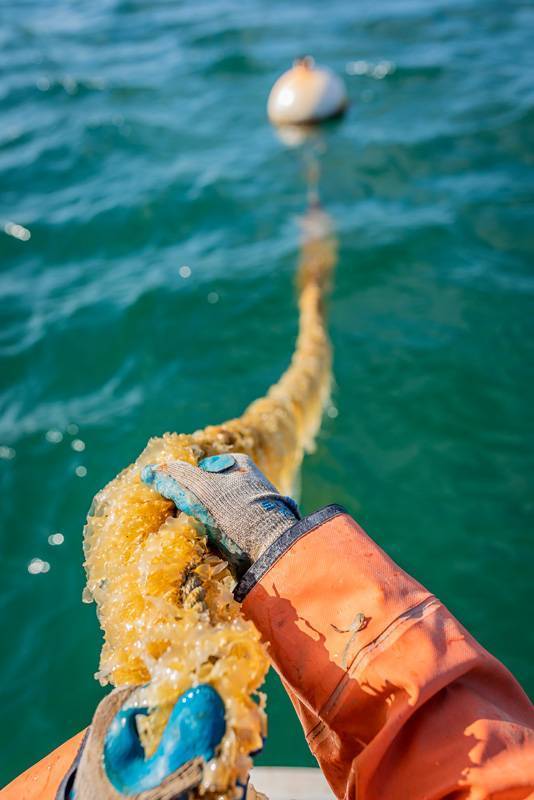
When they were contacted by the MV Shellfish Group about the potential to add seaweed to the mix, they were equally responsive. The Shellfish Group was in contact with Scott Lindell, a research specialist in marine farming for the Woods Hole Oceanographic Institute (WHOI), who had been experimenting with growing kelp and looking for potential farms in Massachusetts. (Lindell and his work can be viewed in a TEDxCambridge talk titled Farming the Ocean to Feed the World. On the Island, they tried a few locations, including Menemsha, inside the lagoon, and at the Martino’s oyster farm, and compared notes at the end of the season. “That first year was trying to find a good site to see how it would grow and where it would grow,” says Dan. “We realized quickly this was something where we were in the right place at the right time with all the players,” notes Greg.
If they could grow it, the benefits to the local environment seemed important. What makes seaweed helpful as a climate solution is that it absorbs carbon dioxide (CO2), a greenhouse gas and by-product of burning fossil fuels. Our oceans absorb about ⅓ of the CO2 released into the atmosphere. As a result, they are not only warming but have become about 30 percent more acidic because when CO2 dissolves in the water, it creates carbonic acid. That acidification, in turn, has all kinds of negative impacts on shellfish, coral, and plankton making it more difficult for them to form their shells and skeletons, and dissolving existing shells. Like trees, seaweed absorbs CO2 from the water through photosynthesis and, in the process of converting it into their own food, releases pure oxygen back into the ocean. Having these kelp farms or forests can also help protect coastal areas by lessening the impacts of storms and storm surges. And, they create habitat for fish, crabs, and sea animals.
“I don’t want to paint too rosy a picture,” says Greg. “I don’t think this is the solution, but I think it’s part of the solution, in a multi-faceted way. For one thing, he says, it’s zero input. “You’re creating food, and as a sponge, you’re removing carbon. Oysters are absorbing phosphorus and nitrogen, and seaweed is absorbing excess carbon out of the ocean and you’re applying [those] to something else, like gardens or food. It’s a good way to grow sustainable choices that can supplement a growing population.”
Put another way, says his brother Dan, “if you go to a restaurant and order spaghetti and meatballs, that one pound of beef is 2,500 gallons of water, 12 pounds of grain, 35 pounds of soil, and a gallon of gasoline to make. If you just chose clams, instead of beef, you’re going to remove all of that out of the equation.”
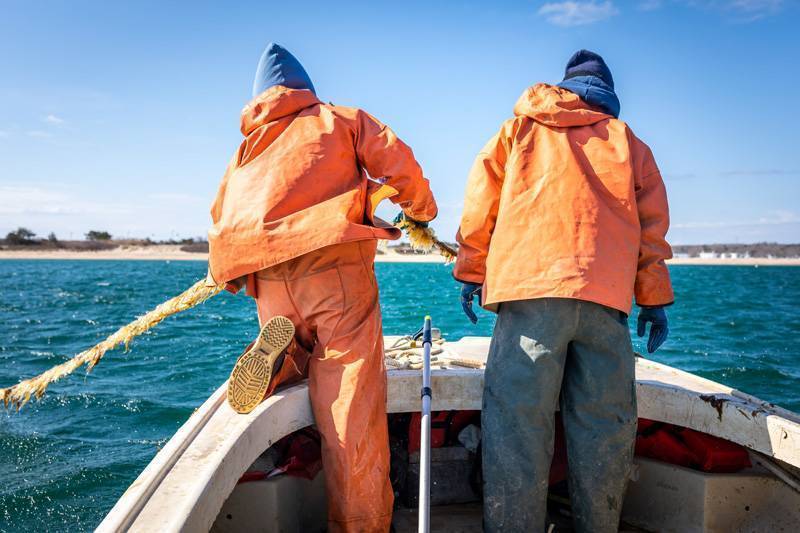
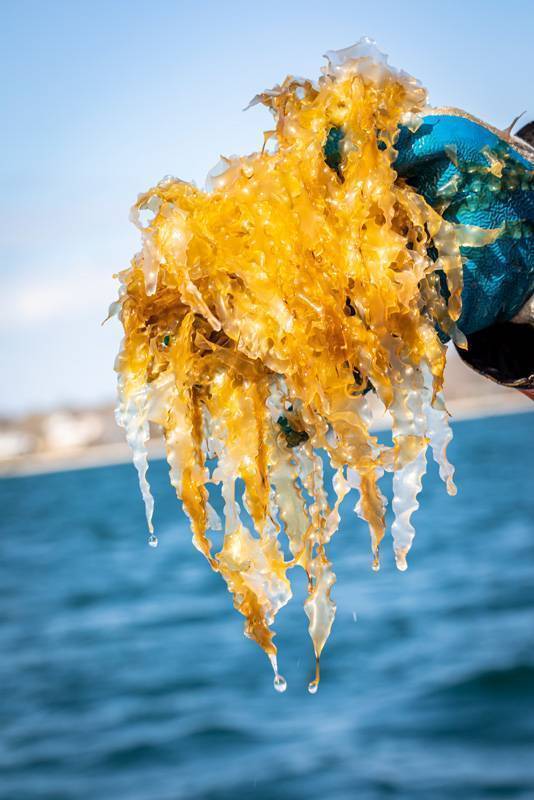
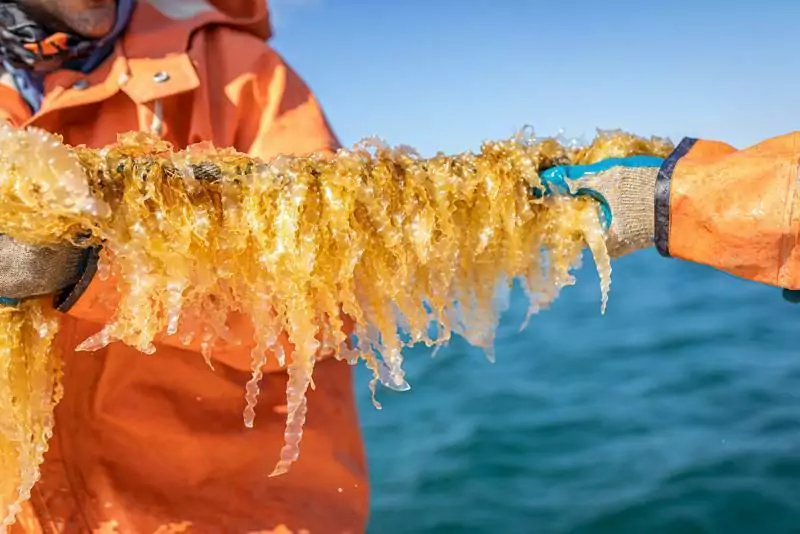
Once they realized sugar kelp could grow here, Greg and Dan set out to get a license from the state to grow it. This was new to everyone — the state had never granted a license for seaweed aquaculture; nor did they have any regulations in place for growing, handling, or selling. The brothers worked closely with and credit Chris Schillaci, formerly of the Massachusetts Division of Marine Fisheries, for helping to implement the new process. Cape and Islands Senator Julian Cyr and the MV Shellfish Group were also instrumental in the process, and Cyr has visited the farm. In 2016, Cottage City received the state’s first license to grow and market kelp. Not far behind them were kelp farmers in Chatham, Harwich, and Wareham.
They also received help from Thimble Island Farm kelp and oyster grower Bren Smith, a kelp evangelist who’s been on 60 Minutes, in National Geographic, and honored for being a pioneer in regenerative ocean farming. Smith had gone through the permitting/regulatory process in Connecticut and shared information, especially in the food handling and harvesting aspects of seaweed. Smith founded GreenWave, a non-profit developed to help expand kelp farming — imagining farms up and down the eastern coast and a potential multi-billion dollar market. Worldwide, the seaweed market was already an $11 billion industry, primarily in Asian countries. Why not here? Smith, who had been turned off by the negative excesses of fish farming, saw the benefit that farmed seaweed and shellfish could play in addressing climate change and as a food source, and gravitated toward, as he puts it, “growing things that don’t swim away and that you don’t have to feed.”
The work Smith and others are doing should help pave the way for the Martinos and other 3D marine farmers to come. At first, Smith called kelp the new kale, an early slogan. But he soon recognized some difficulties in marketing to chefs and the public unfamiliar with incorporating seaweed into their diet. Through GreenWave, Smith has turned his sights onto something bigger — turning kelp into the new soy. Instead of using soy as a base for products, Smith wants kelp, with its nutritious and sustainable growing profile to be used everywhere — as an ingredient for animal feeds, base for foods, cosmetics and even bio-plastics. They may be onto something with the potential addition to animal feed. A recent study out of the University of California, Davis showed how adding just three ounces of seaweed to animal feed could reduce by up to 82 percent the polluting methane gas emitted into the atmosphere by cows.
To feed a growing world population, marine biologists hope we can shift some farming from land to the vast sea, which can be a model of sustainability. Seaweed — and shellfish for that matter, too — need only naturally occurring nutrients in the water to thrive and grow.
How does it grow?
Through GreenWave, Smith also sells the seed spools that Dan and Greg use to grow the kelp. The brothers take the spool string, which comes by ferry, and wrap it around their own ropes, attached to the buoys on either side where it grows, absorbing ocean nutrients.
To care for the seaweed, Dan and Greg will occasionally check on the ropes, especially in that first week to see if the tension is right, not dragging anywhere near the ocean floor. And they check after any major storm to make sure it’s growing well. “That’s it,” says Dan. “It’s kind of like watching grass grow.”
At the same time, they are checking on their growing clams and oysters as well. The day we accompanied them, they pulled up several of the 400-pound oyster cages and harvested those ready for market, in addition to harvesting the sugar kelp. “It also benefits our oysters,” explains Dan, who says some seaweed breaks away normally or during a storm. “They’re eating some of the seaweed we’re growing.”
As part of regulations, and being a test site, the brothers periodically send in water samples. “We have some of the best water, quality wise,” notes Greg about the Vineyard. And they’ve been contacted by Southern Connecticut State University, which is also studying the process. This means ferrying guests from the university to the site and sharing data.
The brothers said at first they weren’t sure how to sell or market the seaweed. They laughed and joked that some of their first early deliveries to friends and interested consumers felt like clandestine “weed” deliveries. Now, in addition to a fresh seaweed market when harvested in the spring, they freeze a lot of it to sell at the West Tisbury Farmers Market. They only joined the market during the pandemic year to sell their oysters when restaurants were closed but have found the market helpful and expect to continue. They sell the frozen raw kelp by the pound, dried kelp flakes and smoothie kelp cubes.
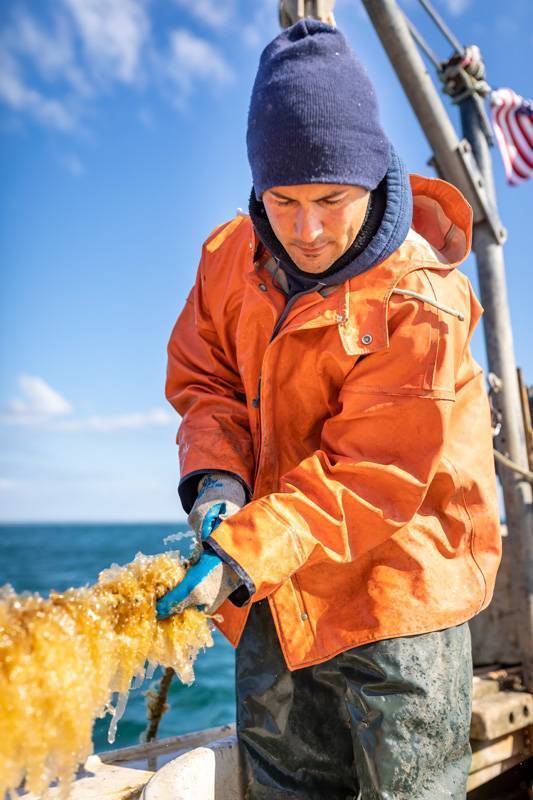
The key to selling oysters — and they predict the same might be true for the sugar kelp — is wholesale. And right now, the jury is out whether chefs will find it a useful product.
“You can sell an unlimited amount of oysters,” says Dan. “But with seaweed, there’s a limit because demand isn’t there.”
There are signs, however, that things may be changing. “At first it was ‘who would even want to even eat that,’” Greg says. “The marketing of seaweed is not all that appealing and appetizing. People think of that low tide smell and all that seaweed. But when you start naming it sea vegetables or sea greens that’s when the marketing really matters.
“I think that what we’re starting to see, through our sales and deliveries, it is becoming more common. People have a good understanding of the eco-benefits of it. Everyone I’ve spoken to has found some way to eat it and enjoy it. We always have new clients that are reaching out.”
Right now, the revenue stream from selling the seaweed is “negligible,” says Dan. “If we sell what we have, that’s great,” adds Greg. “But overall, it’s a blip on the radar.” Where the industry goes and whether it changes, remains to be seen. “We’re all just figuring this out, where does it all fit in,” he adds.
Kelp in the kitchen
I came home with a one-pound bag of kelp to begin experimenting. My goal was three good recipes for this magazine. I ended up with about a dozen good recipes (getting another pound in the meantime).
It helps that I am a recipe developer by trade. But the truth is, I fell in love with the sugar kelp, especially this fresh version, ribbons of delicate kelp, with a sweet ocean scent, tender. And healthy!
I brushed up with suggestions from friend Roxanne Kapitan, who had been getting fresh kelp deliveries for at least two years. She chopped it up and added it to scrambled eggs with tarragon, smoked paprika and other fresh herbs, which I recreated. Delicious! It was wild watercress season, and she chopped the kelp and added it to a wonderful watercress salad with roasted red pepper and feta. Her favorite combination though was a kale salad massaged with garlic, olive oil, and salt with lemon zest, chopped kelp, and an herbal apple cider dressing.
“Anything that’s bitter, that seaweed goes fantastically with,” reports Roxanne. “It’s a textural complement to the bitter flavors.”
I figured it would naturally complement fish. I tried fresh crabcakes, lightly flavored with some lemon, chives, red pepper for color, and a dash of mayonnaise. I mixed in about ½ cup of the chopped kelp at the end. Honestly, it’s hard to gauge what flavor the kelp adds because it is fairly mild but I’ve made them two or three times since, and the recipe made the cut. With the leftover crab, I tried a kelp and crab fried rice (yum), and then a fried rice with kelp and veggies (ditto).
The Martinos stuck a few fresh oysters in my order and I figured I might help them in their raw bar catering business by creating a tiny seaweed salad topping for raw oysters. I blanched the kelp for 30 seconds and added some sesame oil, rice vinegar, ginger, and a few other ingredients. The blanching shrinks the kelp somewhat, makes the texture a little more slippery and turns it light green. Unfortunately, this seaweed accent did not enhance the fresh oysters in this case, though I think a seaweed topping, with experimentation, would work.
What did work was a kelp butter, made earlier in the day with softened butter, lemon, shallots, and tarragon, then refrigerated. This makes an instant sauce later for fish. It worked perfectly with the panko-coated fluke that I sautéed. I’ve made this for friends who raved, and am sharing that recipe here too.
Kelp can be dried and used as a flavor booster or added to salt as a nutritional enhancement. Cottage City dries some of its kelp for sale. Drying it — removing the water — intensifies the salty and sea flavor. So the dried kelp is different from the fresh raw kelp and both are different from the blanched kelp.
One Friday, before heading off Island, I decided to dry some of the kelp in my fridge so it wouldn’t go to waste. I had remembered a crispy seaweed snack we made in cooking school with maple syrup and sesame seeds. I separated the strands and rubbed them with maple syrup, then placed them on parchment paper and sprinkled with sesame seeds. I put the oven on 200°F and let the kelp dry for 30 minutes or so. I happily munched on the results on the boat ride — a crispy dried kelp with a sweet and lightly salty flavor.
I never looked up kelp or seaweed recipes, but I know seaweed is commonly added to many Asian soups, including miso soup. So I made a miso soup with leeks, ginger, kale, and kelp. I felt virtuous with each spoonful. Later, when clients gave me some homegrown shiitakes to use for one of their meals, I made a kelp shiitake ramen noodle soup. I highly recommend this.
This all led to one of my favorite uses, a kelp clam chowder — perfect for Martha’s Vineyard. My friend Jessica Roddy had already adapted a New York Times chowder recipe and I used that. She, though, had dug the clams, and shucked them herself, and added the raw chopped clams to the hot broth. We enjoyed her version around a firepit during COVID, and the group consensus was that it was the best chowder we had ever eaten. I later used that same adaptation (but lightly cooked the clams to open them) and added a handful of chopped kelp ribbons with the clams. I’ve made that chowder a half-dozen times. It worked so well, I rushed a quart down to the Martinos, and said ‘you guys need to make and sell this,’ especially since they grow clams as well. I pictured a chowder cart in OB: Cottage City Kelp Chowder. They thought of the Farmer’s Market and asked if I had a commercial kitchen.
What do you think? Do you think it would be a success?
We’ll see what the future brings. But good luck to the Martino brothers and all those who are thinking and caring about the future of our oceans and food.
Tour the Cottage City Oyster Farm
Greg and Dan offer boat tours to their oyster farm during the summer months. Their new 31-foot custom open-deck boat can take up to 20 people. Billed as a floating raw bar experience, this educational tour, which lasts about 1½ hours, teaches guests about the process of growing oysters from seed to market, and they can enjoy oysters directly from the source. The tours are perfect for events, oyster aficionados, and those seeking an understanding of where their food comes from. Children must be at least 13 years old and accompanied by an adult. For details and dates, go to Cottagecityoysters.com

